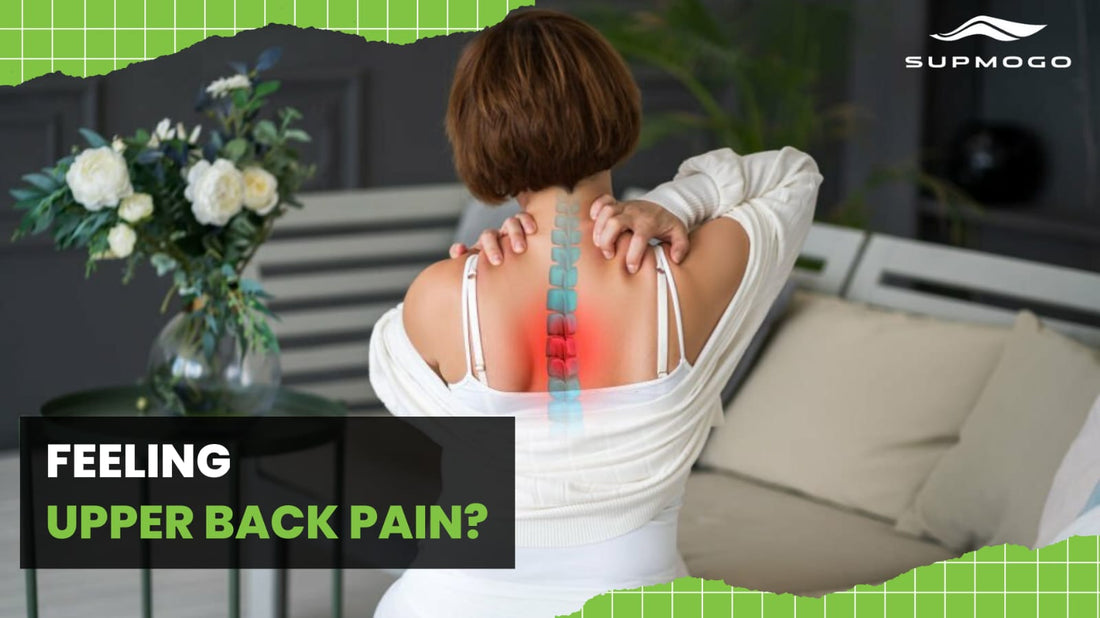An upper back pain suddenly strikes you while you are busy completing an upcoming presentation. A constant dull ache lingers in your back and makes work difficult.
Do you know why this happened? And how can you manage it without disturbing your workflow?
SUPMOGO knows why this striking pain in your back occurs, so we've put together this complete guide to unveil the reasons for pain in the upper back, its risk factor, and some remedies to treat it at home.
Here's what you'll learn in this article.
- What is Upper Back Pain?
- Upper Back Structure
- Symptoms of Upper Spine Pain
- 6 Risk Factors of Pain in the Upper Back
- Age
- Lack of Physical Activity
- Obesity
- Psychological Conditions
- Underlying Conditions
- Smoking
- What Causes Upper Back Pain?
- Lack of Exercise
- Poor posture
- Muscle Overuse
- Improper Desk Set Up
- Clothing and Bags
- Stress
- Mattress Quality and Pillow Position
- Other Conditions
- How is pain on upper back diagnosed?
- How can I prevent upper back pain?
- Treatment of back pain
- Ultimate Solution of Upper Back Pain | SUPMOGO Regenerative Wearable Belt
What is Upper Back Pain?
Pain at the upper back is less common than in the lower back. Mayo Clinic reviewed studies and found that almost one-fifth of people reported upper back pain, while about a third of people suffered from lower back pain. [1]
To know why pain in the upper back occurs, we first need to understand the structure of the back.
Upper Back Structure
Our back can be divided into three regions which include:
- Cervical Spine (The top area that runs along the back of the neck)
- Thoracic Spine (Middle section that joins the lumbar and cervical spine with a set of 12 vertebrates)
- Lumbar Spine (Bottom portion which connects the spinal column to the tailbone)
In simpler words, the upper back lies between the neck and lower back. It is attached to the rib cage, so it's the most stable part of the spine with a limited range of motion. Besides shock absorbing and elastic disks on both sides of vertebrae, the upper back protects the spinal cord.
You may sometimes hurt your lower back muscles while performing different activities like playing a sport or even picking up the grocery with the wrong posture. However, it is less common in the upper back region since your thoracic spine rarely moves; hence, it's less vulnerable to injuries.
But this doesn't mean you are safe from any injuries to the upper back. Below, we have listed all the conditions that can lead up to upper back pain.
Symptoms of Upper Spine Pain
Various activities and games like tennis can lead to back pain in the upper back region. You may experience the following symptoms:
- Radiating pain along a nerve
- Burning or sharp sensation
- Tenderness to touch
- Stiffness
- Tightness
6 Risk Factors of Pain in the Upper Back
Some factors can increase the likelihood of getting back pain. For instance:
1. Age
Back pain is more common in people of older age.
2. Lack of Physical Activity
Staying active keeps your muscles healthy. In contrast, when you are physically inactive, you have weak muscles and the chances of getting injured increase.
3. Obesity
Extra weight, especially belly fat, can put more strain on the soft tissues of your back.
4. Psychological Conditions
According to a study, a stressful psychosocial environment increases employees' risk of back pain.[2]
The complete phenomena behind it are still unclear, but it has been observed that stress and depression can make back pain worse.
5. Underlying Conditions
Certain diseases like arthritis and cancer also cause back pain.
6. Smoking
According to a meta-analysis, the incidence, and prevalence of back pain are more in smokers than in non-smokers.[3]
Smoking reduces blood flow and may degenerate the spinal discs due to the limited availability of nutrients. Also, it delays healing, so quitting smoking can help against back pain.
What Causes Upper Back Pain?
Pain at the upper back is also called TSP (Thoracic Spine Pain), and it can occur due to the following reasons:
1. Lack of Exercise
You are at greater risk of developing back pain if you have a sedentary lifestyle.
According to research, an exercise is a therapeutic tool used to improve the strength and flexibility of the back.[4]
Also, a lack of physical activity increases the chances of becoming obese, a risk factor for upper back pain.
2. Poor Posture
Most spine-related issues originate from poor posture.
If you are habitual of sitting in the wrong position, you put extra pressure and strain on your delicate muscles and bones. So, it may result in shoulder pain, lower back pain, headache, and upper back pain.
3. Muscle Overuse
Besides, repetitive activities like playing sports or leaning over a computer may tear or twist the muscles & tendons. Sudden collisions or impacts also increase the chances of getting a back injury.
Muscle overuse can lead to irritation, muscle strain, or tightness. Overlooking these symptoms might make them worse and can result in chronic back pain.
4. Improper Desk Set-Up
Do you work from home or have a desk job that requires you to spend most of your time in a chair? Then you need to pay more attention to your desk set-up.
An improper desk or chair can make you vulnerable to several health issues. These include musculoskeletal problems, backaches, headaches, strained eyes, etc. Consider spending in an ergonomic chair and a standing desk. Alternating your posture while continuously working can help you increase blood flow to your muscles.
Another great thing that you can opt for while working is the SUPMOGO RecoveryFlex System. This RecoveryFlex System features EMS technology that naturally connects with your brain and generates impulses to contract and relax your muscles. This means that your back and core muscles exercise independently without having you move or stress about exercising your back muscles. This fitness wearable belt also helps posture correction and muscle recovery by driving lactic acid away and bringing oxygenated blood into your muscles.
5. Clothing & Bags
Improper clothing and bags may also cause backaches and other interrelated problems. For instance, wearing a heavy backpack for long hours can lead to muscle spasms and back pain.
High heels also disturb the spine's natural alignment and place additional stress on your feet, ankles, knees, and back. Similarly, worn-out shoes don't provide the needed support and can lead to back aches.
The SUPMOGO Belt also treats inflammation and reduces strain on the muscles to relax your body.
Here are 10 reasons why you should exercise and strengthen your back muscles.
6. Stress
Stress increases the production of cortisol and gives birth to achiness and inflammation. It also makes back muscles tense and may even lead to spasms.
People with stress and depression have difficulty managing their back discomfort.
According to a systematic review, stress-reducing activities like mindfulness can help to manage back pain.[5]
7. Mattress Quality & Pillow Position
Poor mattress dip in certain areas fails to provide the proper support to your back. Over time, it results in misalignment of the spine, muscle strain, poor sleeping posture, and back pain.
Similarly, pillow position and height also play a vital role. Sleeping on too-high pillows bends your neck abnormally, resulting in neck, shoulder, and back pain.
8. Other Conditions
Besides, certain medical conditions can lead to upper back pain. These include:
- Scoliosis
- Degenerative Disk
- Sciatica
- Osteoarthritis
- Spinal Stenosis
- Gall bladder issues
- Fractured Vertebra
- Myofascial pain syndrome
How is Pain on the Upper Back Diagnosed?
Your physician will ask you various questions to determine the reasons for your upper back pain. These may include:
- What's your activity level?
- What are your symptoms?
- Which activity makes your back pain worse?
- Does anything make you feel better?
Do you have any medical history related to back aches or anything else?
Besides, your doctor may ask you to sit, stand or walk around to notice how the upper back pain affects your movements. In some cases, the following tests can be conducted for a better diagnosis of upper spine pain:
- Blood Test
- Spine X-ray
- MRI or CT scan
- Nerve Studies
- Electromyography (EMG)
- Bone density test
How I Can Prevent Pain in Upper Back?
Below mentioned tips can help you to prevent upper back pain:
- Practice good posture
- Take regular breaks from work to relax your muscles
- Provide proper support to your back when sitting
- Stay physically active and do light exercise regularly
- Bend at your knees instead of bending from the waist while lifting heavy objects
- If your mattress is 6 to 7 years old, then replace it
- Have a regular massage to relieve the muscle tension
- Make it your habit to do stretching exercises daily
- Maintain a journal and note down the activities which provide relief and those which make this pain worse
It can be managed conveniently at home if you have mild to moderate upper back pain.
Treatment of Back Pain
Consult a medical professional if home remedies don't work. For severe or chronic back pain, a doctor may suggest the following:
- Pain killer, muscle relaxant, or cortisol injections
- Physical Therapy
- Surgery
Ultimate Solution of Upper Back Pain | SUPMOGO Regenerative Wearable Belt
Tired of trying home remedies but still can't get relief from upper back pain? Or just looking for an easy solution that doesn't disturb your daily activities?
Well, whatever your situation may be, our revolutionary SUPMOGO RecoveryFlex System for upper back pain can help!
Made by world-class doctors and engineers, the SUPMOGO RecoveryFlex System can strengthen the deepest layers of your muscles and provide immediate pain relief. It contains Nano-scale silver that uses water-activated EMS technology to transmit signals to the brain and reduce pain and inflammation while providing 10X faster pain relief and recovery.
Wondering how a pain relief belt can target your deepest muscles?
This fitness wearable belt uses EMS technology that works in conjunction with the Smart Remote App. This means that you can customize your pain relief section and reach the deepest muscles to eradicate any pain and target the root cause of your discomfort.
Increase the intensity, pulse, and rest according to your endurance and seize the pain from its origin.
Final Takeaway!
Upper back pain is less common than lower back pain and is caused due to muscle overuse, injuries, bad posture, or some medical conditions.
Simple remedies can treat mild to moderate back pain at home; however, you should visit a physician if it doesn't get well after a few trials of home remedies.
Want to get quick relief from back pain? Use our SUPMOGO RecoveryFlex System to manage all spine-related issues!
[1] Henschke, N., Kamper, S. J., & Maher, C. G. (2015, January). The epidemiology and economic consequences of pain. In Mayo Clinic Proceedings (Vol. 90, No. 1, pp. 139-147). Elsevier.
[2] Johnston, J. M., Landsittel, D. P., Nelson, N. A., Gardner, L. I., & Wassell, J. T. (2003). A stressful psychosocial work environment increases the risk of back pain among retail material handlers. American journal of industrial medicine, 43(2), 179-187.
[3] Shiri, R., Karppinen, J., Leino-Arjas, P., Solovieva, S., & Viikari-Juntura, E. (2010). The association between smoking and low back pain: a meta-analysis. The American journal of medicine, 123(1), 87-e7.
[4] Rainville, J., Hartigan, C., Martinez, E., Limke, J., Jouve, C., & Finno, M. (2004). Exercise as a treatment for chronic low back pain. The Spine Journal, 4(1), 106-115.
[5] Anheyer, D., Haller, H., Barth, J., Lauche, R., Dobos, G., & Cramer, H. (2017). Mindfulness-based stress reduction for treating low back pain: a systematic review and meta-analysis. Annals of Internal Medicine, 166(11), 799-807.

